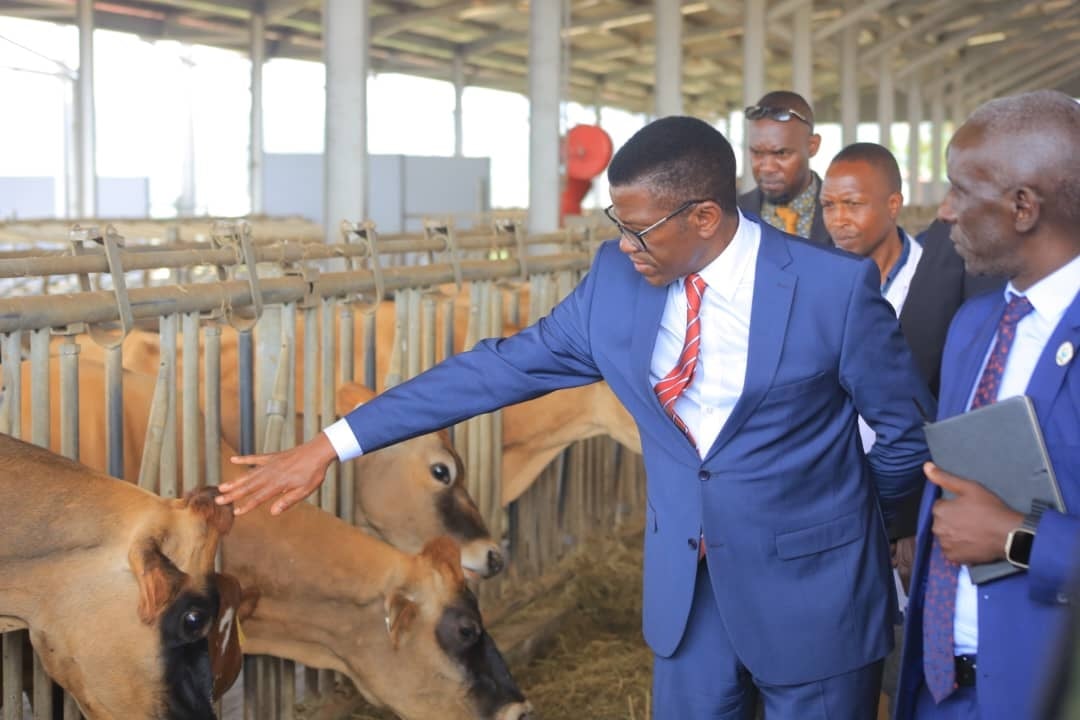Prime
Fertilisers that boost your soil with nutrients

Fertiliser agronomist Julius Ahangaana (left) explains to a farmer, John Kizza, how to use pesticides. Photo | Michael J Ssali
What you need to know:
- The SOILS-S2P initiative aims at scaling up the use of good agricultural practices, including soil fertility and health, quality seed, and advisories, for accelerated results and impacts.
Soils in Uganda are of inherent poor fertility with low nitrogen and phosphorous availability.
Nutrient removal in crop harvests and losses through runoffs and soil erosion is not adequately compensated by using crop residues, manure and fertiliser resulting in negative nutrient balances in all soils in the country.
This therefore calls for user of fertiliser which is well blended with the required nutrients at an optimum amount to make it affordable to farmers.
As such scientists at the National Agricultural Research Laboratories (NaRL) are working with partners to blend the necessary nutrients to come up with fertiliser containing essential nutrients which once used will boost the soil nutrient resulting into improved yields.
Background
The scientists at NaRL leading the programme soils, environment and agro meteorology with partners from the International Fertiliser Development Centre and USAID Feed the Future have developed a project dubbed SOILS-Space to Place (S2P) initiative to address the challenge of soil infertility in the country.
The primary objective of the project is to enhance fertiliser use efficiency and reduce fertiliser wastage among resource constrained smallholder farmers through optimal use.
This is a three year project which started last year running through to 2025 where the scientists are conducting field trails in various agro ecological zones.
Once the trials are done and team comes up with a finished product, it will be submitted to fertilizer companies to develop the blended fertilizers for farmer uptake.
Project implementation
Dr Cranmer Kawuki Kayizzi the project leader explaining to Seeds of Gold noted that trials began last year and they are conducted in zonal research institutes covering the different agro ecological zones.
They include Kachwekano Zonal Agricultural Research and Development Institute, Rwebitaba Zonal Agricultural Research and Development Institute, Bulindi Zonal Agricultural Research and Development Institute, NGETTA Zonal Agricultural Research Development Institute, Buginyanya Zonal Agricultural Research and Development Institute and the National Crops Resources Research Institute (NaCRRI) Namulonge.
What the team is doing is balancing the fertilizer combination to give the required nutrient to the soil.
The trials are done for selected crops namely maize, sunflower, Irish Potato, and upland rice. These trials include Fertiliser Optimisation Trials (FOT) and fertiliser rate trials.
In the trials the team is concentrating blending fertiliser such as urea, DAP, NP and K.
In case the blended fertiliser performance is not as expected, the team is blending secondary nutrients such as sulphur, zinc, boron and copper.
Once the formula works and the data will be collected, it will be given to fertiliser firms such as Yara to come up with the right formulation which can be accessed by farmers.
Dr Kayizzi contends that every plant requires a specific fertiliser blend and therefore farmers growing various crops must look for specific fertiliser type.
In as far as FOT is concerned, there is already developed tool which enables farmers to access what quantity of fertiliser to apply in a specific farm.
How the trials are done
The president of International Fertiliser Centre Dr Upendra Singh explained that this kind of initiative in done in a number of African countries in a bid to help small holder farmers obtain better yields by enriching the soils.
For the case of the trials in Uganda, he notes that there will be various trials for FOT and fertiliser rate trials depending on each crop.
Scientists speak out
The director NaRL Dr Robooni Tumuhimbise noted that farmers in the country have experienced challenges in soil fertility arising from soil erosion, soil silting due to heavy rains but this has to be addressed.
Giving the statistics, he said only 1 percent of farmers are using fertilisers to boost their soil fertility and this incudes those using manure.
To him since soil supports life of animals, crops, forests and humans among others, the issue of replenishing it using fertiliser application is important.
This therefore means when applying the fertiliser in farmer fields, they must consider whether they are applying the right source of nutrient.
It must be applied at the right rate and the right time. It is important farmers to know that fertiliser application is done during planting.
And lastly the fertiliser application must be done using the right method. This means broadcasting is not encouraged.
Dr Sadik Kassim the deputy director-general in charge of agricultural technology promotion at Naro noted that the type of crops farmers grow in Uganda are heavy consumers of soil nutrients.
This means the soils must be replenished to make them fertile and this can be done by adopting fertiliser use and other inorganic inputs including application of manure.
Recommendations
The experts contend that Uganda’s agricultural productivity is only one third of potential yield demonstrated on research fields due to low inherent and declining soil fertility, nutrient mining, poor adoption of productivity enhancing technologies, low use of organic and inorganic fertilisers and drought at critical stages of crop growth and limited rainfall in semi-arid and arid areas.




